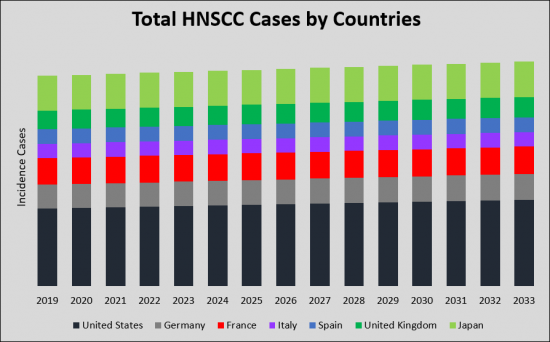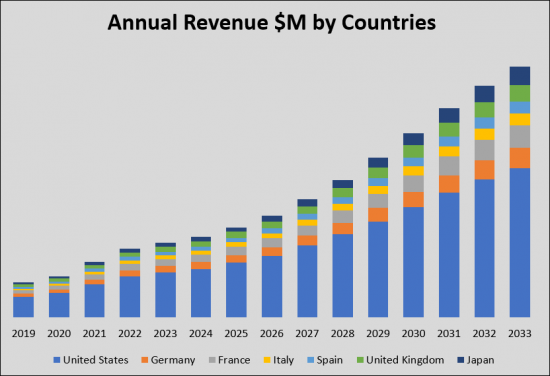 |
市場調查報告書
商品編碼
1307859
頭頸椎鱗狀細胞癌(HNSCC)市場:1次調查(KOL的洞察) - 市場情報 - 流行病學和到2033年前的市場預測Head and Neck Squamous Cell Carcinoma (HNSCC)| Primary Research (KOL's Insight) | Market Intelligence | Epidemiology & Market Forecast-2033 |
||||||
頭頸鱗狀細胞癌(HNSCC)市場主要由當前的治療標準驅動,例如手術切除、放療、化療、西妥昔單抗和免疫療法。到 2033 年,由於新療法的引入和推出,市場預計將發生變化。在 HNSCC 治療領域,當前的 SoC 將下降,新興療法將佔最高的市場佔有率。七個主要國家(美國、法國、德國、意大利、西班牙、英國和日本)治療 HNSCC 的新興療法銷售額在 2019-2033 年研究期間經歷了高速增長,到 2033 年預計將達到 7.5 美元十億。


本報告提供全球頭頸椎鱗狀細胞癌(HNSCC)市場相關調查,提供市場現狀,以及病例數趨勢,患者趨勢,競爭產品的市場上地位,市場機會等資訊。
目錄
摘要整理
- 主要調查結果
頭頸椎鱗狀細胞癌(HNSCC)疾病的背景
- 頭頸椎鱗狀細胞癌(HNSCC)定義
- 頭頸椎鱗狀細胞癌的生物學
- 原因
- 症狀
- 病因
- HNSCC的分子變化
- 生物標記
- 診斷
流行病學和患者族群
頭頸椎鱗狀細胞癌(HNSCC)的流行病學和模式參數的主要的資訊來源
- 美國
- 德國
- 法國
- 義大利
- 西班牙
- 英國
- 日本
目前治療方法和醫療行為
未滿足需求
新的治療方法
- 開發平台(管線)概要
- 頭頸椎鱗狀細胞癌(HNSCC)的治療開發平台
- 產品分析
- ASP-1929(Rakuten Medical Inc.)
- zebinapanto(Merck)
- Atezolizumab(Roche)
- buparurishibu(Adlai Nortye)
- Lenvatinib+ Pembrolizumab(Merck/Eisai)
- NBTXR3(Nanobiotix)
- Eftilagimod alpha(Immutep)
- petosemutabu(Merus)
- HB-200(Hookipa Pharma)
- evorupaseputo(ALX Oncology)
- tipifarunibu(Kura Oncology)
- fikuratsuzumabu(Aveo Oncology)
- 產品分析
治療研究
價格調查
未來的治療範例
目前治療方法和新的治療方法的年度成本
市場預測
- 主要調查結果
- 到2033年前的各國市場預測
各國市場預測
- 美國
- 德國
- 法國
- 義大利
- 西班牙
- 英國
- 日本
推動市場要素與阻礙因素
The Head and neck squamous cell carcinoma (HNSCC) market is hugely contributed by current standard of care which are Surgical resection, radiotherapy, Chemotherapy, Cetuximab, Immunotherapy. By 2033, the market is expected to change due to the uptake and launch of new novel therapies. In a HNSCC treatment setting, the current SoC will decline, and the novel emerging drugs will grasp the highest market shares. The sales of the emerging therapies for the treatment of HNSCC in the study countries (United States, France, Germany, Italy, Spain, United Kingdom and Japan) will experience high growth over the 2019-2033 study period, adding a value estimated at a total market of $ 7.5 billion by 2033.
"Initial therapy may include combinations of surgery, radiation, and platinum-based chemotherapy but the recurrence after platinum based chemotherapy is associated with a particularly dismal prognosis. Average survival for these patients is less than 6 months. I have been treating patients for 20 years, the disease is devastating, with patients having significant issues with speech, swallowing, and breathing."
Head and Neck (H&N) Cancer's address tumors originating from the oral cavity (including the mucosal lip), pharynx, larynx, and paranasal sinuses. Squamous cell carcinomas account for more than 95% of these tumors. Tobacco and alcohol use disorders are the most common etiologies for oral cavity, hypopharynx, larynx, and Human Papillomavirus (HPV)-unrelated oropharynx cancers. Patients with H&N cancers due to tobacco and alcohol are at risk for harboring synchronous primary tumors and developing second primary neoplasms in the H&N, lung, esophagus, bladder, and other potential sites exposed to these carcinogens.
Surgical resection of the primary tumor and draining lymph nodes followed by risk-adapted adjuvant radiation, with or without platinum-based chemotherapy, or primary definitive concurrent chemoradiation, remain the principal treatments employed for locally advanced HNSCC. It is important to note that multimodality treatment often drastically impacts patient quality of life (QOL). Treatment planning should aim for the most highly curative approach, while optimizing preservation of function.
Recurrent and/or metastatic head and neck squamous cell carcinoma (RM HNSCC) is a challenging disease with limited treatment options. It is often diagnosed when the cancer has spread to other parts of the body or has returned after treatment. The prognosis for RM HNSCC is poor, with a median overall survival of just a few months. However, recent advances in immunotherapy and targeted therapy have shown promise in improving outcomes for some patients with RM HNSCC. Clinical trials are ongoing to determine the most effective treatment strategies for this aggressive form of cancer. Early diagnosis and aggressive treatment are critical to improving survival outcomes for patients with RM HNSCC.
Head and neck squamous cell carcinoma (HNSCC) - Epidemiology
The total HNSCC incident cases in the G7 countries are anticipated to increase to 150,447 cases by 2033 for the study period (2019- 2033). As per estimates, the EU5 accounted for the highest incidence of Head and neck squamous cell carcinoma (HNSCC) cases in 2023 which was 63,239 cases and is expected to increase by 2033 for the study period followed by the United States and Japan. Among the EU5, France had the highest AML cases, followed by Germany, the United Kingdom, Spain, and Italy.

Head and neck squamous cell carcinoma (HNSCC) - Current Market Size & Forecast Trends
The Head and neck squamous cell carcinoma (HNSCC) therapeutics market is expected to experience high growth throughout the study period (i.e., 2019 to 2033) and reach USD 7.5 billion, representing a compound annual growth rate (CAGR) of 13.9%.
The United States captured the highest market share in 2023 compared to the European 5 countries and Japan. The significant growth in the market can be attributed to the strategic adoption strategies implemented by key market players. By 2033, the market share of the United States is projected to increase to USD 4.5 billion, while the European 5 countries and Japan are expected to have substantial market sizes.
During the forecast period (2019-2033), the market growth is expected to grow which is attributed to the several therapies which are currently launched specially in the R/M segments of the HNSCC market. We are expecting the drug utilization of the therapies will further increase including Anti-PD-1, EGFR inhibitors. These established therapies play a pivotal role in addressing Head and neck squamous cell carcinoma, improving patients' quality of life. Secondly, the introduction of innovative drugs such as ASP-1929 (Rakuten Medical Inc.), Xevinapant (Merck), Atezolizumab (Roche), Buparlisib (Adlai Nortye), Lenvatinib + Pembrolizumab (Merck/Eisai), NBTXR3 (Nanobiotix), Petosemtamab (Merus) adds further momentum to the market expansion, ensuring a comprehensive range of treatment options for patients.

Report Highlights:
- Head and neck squamous cell carcinoma (HNSCC) - Current Market Trends
- Head and neck squamous cell carcinoma (HNSCC) - Current & Forecasted Cases across the G7 Countries
- Head and neck squamous cell carcinoma (HNSCC) - Market Opportunities and Sales Potential for Agents
- Head and neck squamous cell carcinoma (HNSCC) - Patient-based Market Forecast to 2033
- Head and neck squamous cell carcinoma (HNSCC) - Untapped Business Opportunities
- Head and neck squamous cell carcinoma (HNSCC) - Product Positioning Vis-a-vis Competitors' Products
- Head and neck squamous cell carcinoma (HNSCC) - KOLs Insight
Table of Contents
Executive Summary
- Key Findings
Head and neck squamous cell carcinoma (HNSCC) Disease Background
- Head and neck squamous cell carcinoma (HNSCC) Definition
- Biology of Head and Neck Squamous Cell Carcinoma
- Causes
- Symptoms
- Pathogenesis
- Molecular Alterations in HNSCC
- Biomarkers
- Diagnosis
Epidemiology and Patient Populations
- Key Findings
- Methods and Data Sources
- Country Specific Incident Cases of Head and neck squamous cell carcinoma (US, Germany, France, Italy, Spain, UK, and Japan)
- Country Specific Stage Specific Cases of Head and neck squamous cell carcinoma (HNSCC)
Key Sources for Head and neck squamous cell carcinoma (HNSCC) Epidemiology and Model Parameters
- United States
- United States incident cases of Head and neck squamous cell carcinoma (HNSCC)
- United States stage specific cases of Head and neck squamous cell carcinoma (HNSCC)
- Germany
- Germany incident cases of Head and neck squamous cell carcinoma (HNSCC)
- Germany stage specific cases of Head and neck squamous cell carcinoma (HNSCC)
- France
- France incident cases of Head and neck squamous cell carcinoma (HNSCC)
- France stage specific cases of Head and neck squamous cell carcinoma (HNSCC)
- Italy
- Italy incident cases of Head and neck squamous cell carcinoma (HNSCC)
- Italy stage specific cases of Head and neck squamous cell carcinoma (HNSCC)
- Spain
- Spain incident cases of Head and neck squamous cell carcinoma (HNSCC)
- Spain stage specific cases of Head and neck squamous cell carcinoma (HNSCC)
- United Kingdom
- United Kingdom incident cases of Head and neck squamous cell carcinoma (HNSCC)
- United Kingdom stage specific cases of Head and neck squamous cell carcinoma (HNSCC)
- Japan
- Japan incident cases of Head and neck squamous cell carcinoma (HNSCC)
- Japan stage specific cases of Head and neck squamous cell carcinoma (HNSCC)
Current Therapies and Medical Practice
- Drugs Approved in G7 countries
- Treatment Algorithm & Future Product Positioning for Head & Neck Squamous Cell Carcinoma
- Treatment of Practices in Head & Neck Squamous Cell Carcinoma (HNSCC)
- Treatment Guidelines (2023 NCCN Guidelines, 2020 ESMO Guidelines)
- SOC Data
- Marketed Therapies
Unmet Needs
Emerging Therapies
- Pipeline Overview
- Therapeutic Developments Pipeline for Head and neck squamous cell carcinoma (HNSCC)
- Product Analysis
- ASP-1929 (Rakuten Medical Inc.)
- Product Profile
- Clinical Development
- Sales & Market Opportunity by 2033
- Xevinapant (Merck)
- Product Profile
- Clinical Development
- Sales & Market Opportunity by 2033
- Atezolizumab (Roche)
- Product Profile
- Clinical Development
- Sales & Market Opportunity by 2033
- Buparlisib (Adlai Nortye)
- Product Profile
- Clinical Development
- Sales & Market Opportunity by 2033
- Lenvatinib + Pembrolizumab (Merck/Eisai)
- Product Profile
- Clinical Development
- Sales & Market Opportunity by 2033
- NBTXR3 (Nanobiotix)
- Product Profile
- Clinical Development
- Sales & Market Opportunity by 2033
- Eftilagimod alpha (Immutep)
- Product Profile
- Clinical Development
- Petosemtamab (Merus)
- Product Profile
- Clinical Development
- Sales & Market Opportunity by 2033
- HB-200 (Hookipa Pharma)
- Product Profile
- Clinical Development
- Evorpacept (ALX Oncology)
- Product Profile
- Clinical Development
- Tipifarnib (Kura Oncology)
- Product Profile
- Clinical Development
- Ficlatuzumab (Aveo Oncology)
- Product Profile
- Clinical Development
- ASP-1929 (Rakuten Medical Inc.)
- Product Analysis
Treatment Studies
- Real-world Treatment Pattern as 2L R/M HNSCC: IO Monotherapy is being prescribed to 67% patients progressed on Platinum-based Chemotherapy
- Treatment Patterns in Recurrent or Metastatic Head and Neck Cancer (R/M HNC) Patients in Japan
Pricing Studies
- Total cost of care for patients with Advanced HNSCC
- Clinical and economic burden of head and neck cancer: A nationwide retrospective cohort study from France
Future Treatment Paradigm
- Head and neck squamous cell carcinoma (HNSCC) Competitor Landscape and Approvals Anticipated
- Future Treatment Algorithms and Competitor Positioning
- Key Data Summary for Emerging Treatment
Annual Cost of Current & Emerging Therapies
Market Outlook
- Key Findings
- Country Specific Market Forecast to 2033
- Sales of Drugs to Treat Head and neck squamous cell carcinoma (HNSCC) in the Major Pharmaceutical Markets, 2019-2033
- Patient Share of Head and neck squamous cell carcinoma (HNSCC) Therapies 2019-2033 (USD Million)
Market Forecast by Country
- United States
- United States Market for Head and neck squamous cell carcinoma (HNSCC) 2019-2033 (USD Million)
- United States Market for Head and neck squamous cell carcinoma (HNSCC) by Therapies 2019-2033 (USD Million)
- Germany
- Germany Market for Head and neck squamous cell carcinoma (HNSCC) 2019-2033 (USD Million)
- Germany Market for Head and neck squamous cell carcinoma (HNSCC) by Therapies 2019-2033 (USD Million)
- France
- France Market for Head and neck squamous cell carcinoma (HNSCC) 2019-2033 (USD Million)
- France Market for Head and neck squamous cell carcinoma (HNSCC) by Therapies 2019-2033 (USD Million)
- Italy
- Italy Market for Head and neck squamous cell carcinoma (HNSCC) 2019-2033 (USD Million)
- Italy Market for Head and neck squamous cell carcinoma (HNSCC) by Therapies 2019-2033 (USD Million)
- Spain
- Spain Market for Head and neck squamous cell carcinoma (HNSCC) 2019-2033 (USD Million)
- Spain Market for Head and neck squamous cell carcinoma (HNSCC) by Therapies 2019-2033 (USD Million)
- United Kingdom
- United Kingdom Market for Head and neck squamous cell carcinoma (HNSCC) 2019-2033 (USD Million)
- United Kingdom Market for Head and neck squamous cell carcinoma (HNSCC) by Therapies 2019-2033 (USD Million)
- Japan
- Japan Market for Head and neck squamous cell carcinoma (HNSCC) 2019-2033 (USD Million)
- Japan Market for Head and neck squamous cell carcinoma (HNSCC) by Therapies 2019-2033 (USD Million)
Market Drivers and Constraints
- What Factors Are Driving the Market for Head and neck squamous cell carcinoma (HNSCC)?
- What Factors Are Constraining the Market for Head and neck squamous cell carcinoma (HNSCC)?













